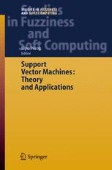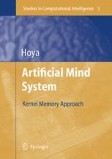Search
Search Results
-
Fast Color Texture-Based Object Detection in Images: Application to License Plate Localization
The current chapter presents a color texture-based method for object detection in images. A support vector machine (SVM) is used to classify each...
-
Gas Sensing Using Support Vector Machines
In this chapter we deal with the use of Support Vector Machines in gas sensing. After a brief introduction to the inner workings of multisensor...
-
Support Vector Machines – An Introduction
This is a book about learning from empirical data (i.e., examples, samples, measurements, records, patterns or observations) by applying support...
-
Improving the Performance of the Support Vector Machine: Two Geometrical Scaling Methods
In this chapter, we discuss two possible ways of improving the performance of the SVM, using geometric methods. The first adapts the kernel by...
-
From Classical Connectionist Models to Probabilistic/Generalised Regression Neural Networks (PNNs/GRNNs)
This chapter begins by briefly summarising some of the well-known classical connectionist/artificial neural network models such as multi-layered...
-
Language and Thinking Modules
In this chapter, we focus upon the two modules which are closely tied to the concept of “action planning”, i.e. the 1) language and 2) thinking...
-
Sensation and Perception Modules
In any kind of creature, both the mechanisms of sensation and perception are indispensable for continuous living, e.g. to find edible plants/fruits...
-
The Mathematics of Learning: Dealing with Data *
Learning is key to develo** systems tailored to a broad range of data analysis and information extraction tasks. We outline the mathematical...
-
Web Page Classification*
This chapter describes systems that automatically classify web pages into meaningful categories. It first defines two types of web page...
-
Sequential Pattern Mining by Pattern-Growth: Principles and Extensions*
Sequential pattern mining is an important data mining problem with broad applications. However, it is also a challenging problem since the mining may...
-
Structural Solutions to Disturbance Decoupling
This chapter develops a novel algorithm which solves the disturbance decoupling problem by repeatedly decoupling one output variable at a time. The...
-
Content Based Image Compression in Biomedical High-Throughput Screening Using Artificial Neural Networks
Biomedical High-Throughput Screening (HTS) requires specific properties of image compression. Particularly especially when archiving a huge number of...
-
Equivalence of Fuzzy Subgroups of Finite Abelian Groups
In this chapter, we determine the number of fuzzy subgroups of certain finite Abelian groups with respect to a suitable equivalence relation. This is...
-
Lattices of Fuzzy Subgroups
Many results concerning relationships between classes of crisp subsets can be carried over to similar relationships between classes of fuzzy subsets....
-
Discriminative Clustering of Yeast Stress Response
When a yeast cell is challenged by a rapid change in the conditions, be it temperature, osmolarity, pH, nutrient or other, it starts a genome stress...
-
Medical Bioinformatics: Detecting Molecular Diseases with Case-Based Reasoning
Based on the Human Genome Project, the new interdisciplinary subject of bioinformatics has become an important research topic during the last decade....
-
13 Haptic Interfaces: Collocation and Coherence Issues
Multi-modality, collocation and immersive VE nowadays represents the break-trough barrier of human computer interaction. Typical VE systems...
-
6 Efficient and Precise Grasp Planning for Real World Objects
With the development of .exible and highly integrated dexterous grip** devices (e.g. fig.6.1) the research results on grasp and manipulation...
-
4 Modelling and Controlling the Compliance of a Robotic Hand with Soft Finger-pads
Compliant pads greatly contribute to increase the robustness and the stability of grasps of robot hands, because of their conformability to the...
-
Cluster Identification Using Maximum Configuration Entropy
Clustering is an important task in data mining and machine learning. In this paper, a normalized graph sampling algorithm for clustering that...
